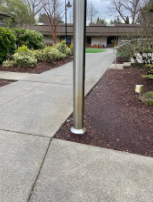Desire Paths: Tracing Trails of Student Stirring
By Chip Downes-Le Guin ‘25
Image by Robin Scott via Geograph
Have you ever noticed the paths created by the constant movement across our school’s campus? Whether you’re late to class, walking on a crowded path, or want to cut a corner, everyday desire paths are being used. These unofficial paths appear over time due to the constant use of students trying to find the most efficient way across the campus.
Desire paths are a transfixing phenomenon, reflecting our own behavior as we cut corners, take shortcuts, and find the most direct route from point A to point B.
Although desire paths often defy the wishes of urban planners or John Harniteaux, they are an interesting presentation of how students choose to move through campus, indicating where foot traffic needs are met, and what parts of campus might need better access.
The Catlin Campus displays many different forms of desire paths, and seeing how and why they form is important to the lore and personability of the campus. This article exhibits some of these paths around campus.
Path 1: A Well-Used Entrance
Another often-seen desire path is at an entrance. In the images below there are examples leading onto and off of the lower soccer field, where people can walk off-campus or to their respective sports like baseball and soccer. The other large entrance path heads into the paddock where many middle school students cut across to get to the barn or play football.
From left → right: entrance to the lower soccer field, path from paddock to the barn, path exiting the campus from lower soccer field.
Path 2: The Corner Cutter
Despite Catlin’s campus having many rounded edges, the occasional cut corner is an essential desire path. Most of these paths have been formed due to people being pushed off of the intended pathway between classes, and golf carts tight turns. You can see stellar examples of corner-cutting across the quad:
Desire paths around the quad
Path 3: The Split Pole
Moving past the quad to the outside of the Diversity and Inclusion office there is another example of corner cutting. I’m sure many of us know someone who no matter what will walk off the path to get around the object. It’s this kind of irrational behavior that has resulted in the formation of this path:
Desire path outside of the Diversity and Inclusion Office
It is worth it to remember that desire paths are not unique to campuses alone. All across public natural environments, you can see desire paths, and recognizing and understanding these paths can help us better design our environments to suit our real needs.
Some urban planners take the influence of desire paths very seriously. Architect and urban planner Ricardo Marini has observed what happens when you don’t: “Somebody spent a fortune putting in granite steps with a piece of landscape next to it, and people go up the slope because their brains tell them that’s the quickest way to do it, even if they get muddy.”
Desire path outside of the Miller Library
Many college campuses have used this information to design their campuses, leaving their campus unpaved and then paving over the mesh of desire paths that are left by the students.
Despite this system creating interesting maps, the majority of the time, landscape architects do know better. The idea of always allowing students to create their own path and then paving over it can have serious implications for the environment.
When soil is compacted it can reduce the absorption of dirt, leading to areas more prone to flooding, and damaged root systems.
The paths that are created are also a problem for facilities that need to keep the paths green and lush.
Many campuses use devices like “staples” - metal barriers that are too high to easily hurdle over and too short to comfortably squat under. Another preventive measure is rainwater tunnels between the side block and the grass in order to prevent potential damage.
Overall, desire paths are an entrance-ing phenomenon that helps to show the human desire to choose their own path, but can detract from the environment you walk on.
So, next time you are walking on campus, take a moment to notice the desire paths around you, and the ones you might be creating.
Desire paths around campus






